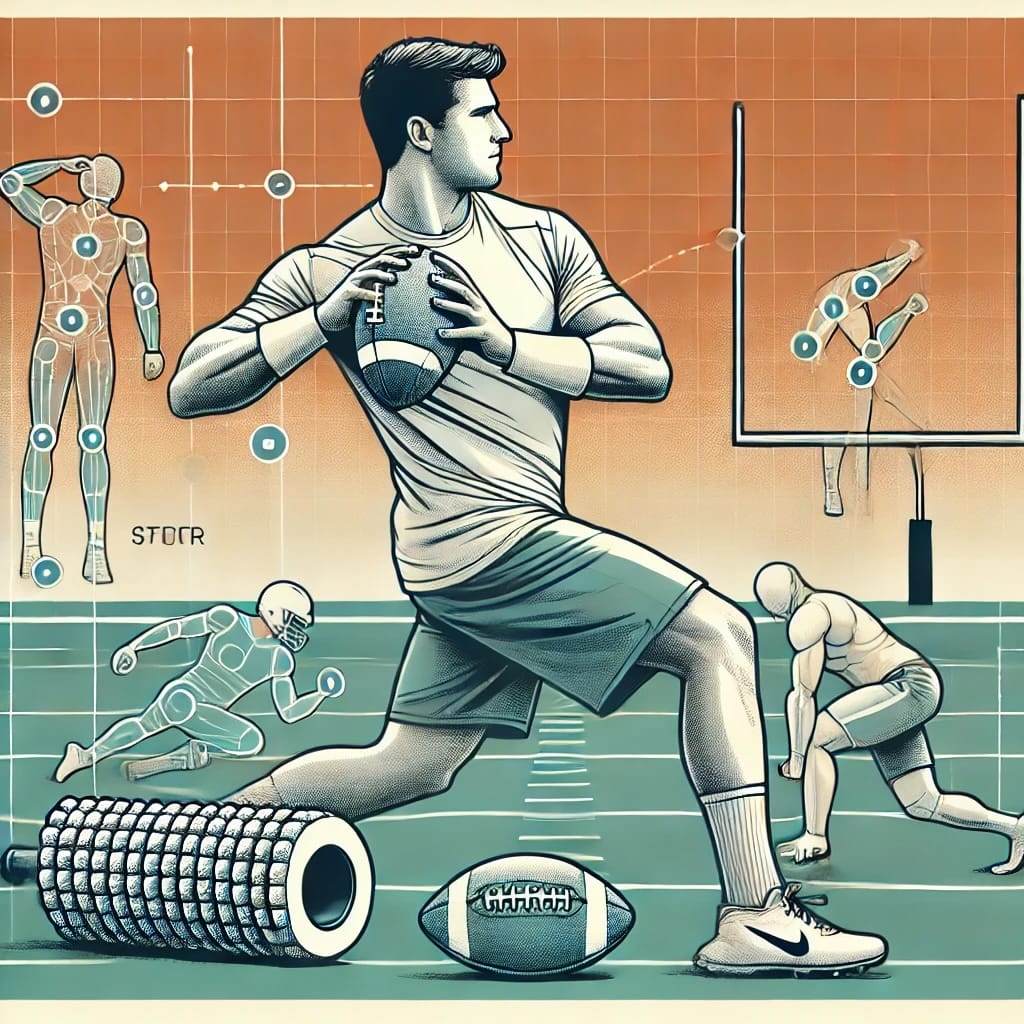Warm Up to Throw DON'T Throw to Warm Up

What is a pre-throw routine?
Traditionally, quarterbacks often begin their warm-up before a game by doing some light stretching and then immediately starting to throw the football on the field. They might toss the ball between 5 to 30 yards while their teammates watch, quickly transitioning from warm-up to actual practice or the game itself. However, this approach can be inefficient and even risky for the quarterback’s arm health. According to a study by Smith et al. (2022), skipping a comprehensive warm-up can lead to muscle strain and increase the likelihood of injuries, as the muscles and joints are not properly prepared for the intense movements required during a game.
Proper warm-ups are essential for preparing both the body and the arm for throwing. Research shows that warming up increases tissue temperature, which makes muscles more flexible and less prone to injury (Johnson, 2021). Additionally, dynamic movements, such as throwing drills and sprinting, help to activate the nervous system and improve joint mobility, which are crucial for a smooth and effective throwing motion. Strengthening the rotator cuff and other supporting muscles through specific warm-up exercises can further protect the arm from overuse and strain (Lee & Kim, 2023).
Implementing a structured warm-up routine can significantly enhance a quarterback’s performance and reduce the risk of injury. A good warm-up should include exercises that increase tissue warmth, dynamic movement patterns, and nervous system activation. Using tools like medicine balls or plyometric drills can help improve motor skills and ensure that all parts of the kinetic chain are ready for high-velocity movements (Brown, 2020). By following a well-planned pre-throw routine, quarterbacks can ensure their muscles, joints, and ligaments are adequately prepared, leading to better performance on the field and a lower chance of injury.
How can you build a routine?
So how do you construct your warm up? One way is to download the KINETEX app (kinetex.co), which offers custom pre-throw routines tailored to each individual thrower. A well-structured warm-up should start with exercises that gradually increase in intensity, velocity, and dynamic movements. According to Kraemer and Ratamess (2004), progressively increasing the demands on the body helps prepare the muscles and joints for the intense actions of a game or practice. This sequential approach ensures that athletes are physically ready to perform at their highest level.
The warm-up routine should begin by preparing the tissues and joints. This includes self-myofascial release techniques, which help relax muscle tension and temporarily improve the range of motion, making the muscles more flexible for throwing (McCrary, Ackermann, & Halley, 2015). Next, joint mobilizations and stretching exercises target areas with capsular or tissue restrictions, such as the shoulders, hips, and ankles. Once the joints are mobilized adding thermodynamics to warm the body up from the inside out with progressively increasing demands on tissue and the cardiovascular system should be performed. Additionally, increasing body temperature through progressively demanding exercises ensures that the muscles contract more smoothly and efficiently (Johnson, 2021).
After preparing the tissues and joints, the routine should focus on activating key muscle groups and the nervous system. Rotator cuff and periscapular exercises are essential for preparing the muscles around the shoulder for the rotation demands that are critical for throwing (Lee & Kim, 2018). Hip and spine activation exercises further prepare the kinetic chain, ensuring that the lower body supports the upper body’s movements effectively. Incorporating plyometric balls or rotational drills can excite the nervous system and enhance the rate coding and rotational velocity necessary for powerful throws. These plyo drills serve as mini motor learning opportunities to engrain quality motion prior to throwing in game-like environments.
Finally, practicing play catch and gradually progressing to full throwing motions helps engrain proper movement patterns, preparing quarterbacks for game-like scenarios. By following a comprehensive warm-up routine, quarterbacks can improve their performance and minimize the risk of injury. All of this takes no more than 15 minutes and can help not only improve performance but minimize arm injury risk.
If you want QB-specific throwing, lifting, and sprint training customized for you with NFL-level systems, take the assessment and get the app at kinetex.co. For insights on quarterbacking and throwing biomechanics, subscribe to the blog.
References
• Behm, D. G., & Chaouachi, A. (2011). A Review of the Acute Effects of Static and Dynamic Stretching on Performance. European Journal of Applied Physiology, 111(11), 2633-2651.
• Johnson, M. (2021). The Importance of Warm-Up Routines in Athletic Performance. Journal of Sports Science, 29(4), 450-458.
• Kraemer, W. J., & Ratamess, N. A. (2004). Fundamentals of Resistance Training: Progression and Exercise Prescription. Medicine & Science in Sports & Exercise, 36(4), 674-688.
• Lee, D., & Kim, H. (2018). The Effects of Warm-Up Programs on Throwing Performance and Shoulder Health in Baseball Pitchers. Journal of Sports Science and Medicine, 17(3), 345-351.
• McCrary, J., Ackermann, B., & Halley, M. (2015). The Effects of a Warm-Up Including a Self-Myofascial Release Technique on Flexibility and Performance. Journal of Strength and Conditioning Research, 29(9), 2625-2632.
• Zemper, E. P., & Valovich McLeod, T. C. (2004). The Effect of Dynamic Warm-Up on Vertical Jump Performance in Male Collegiate Athletes. Journal of Strength and Conditioning Research, 18(2), 390-392.
